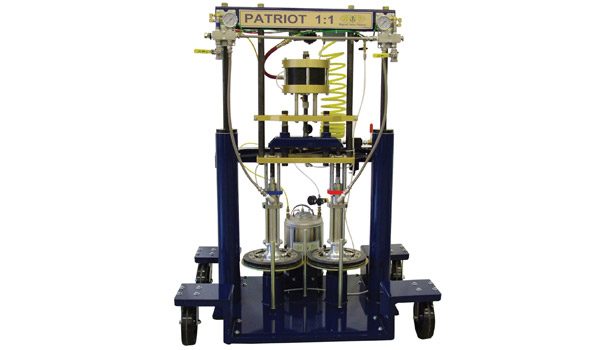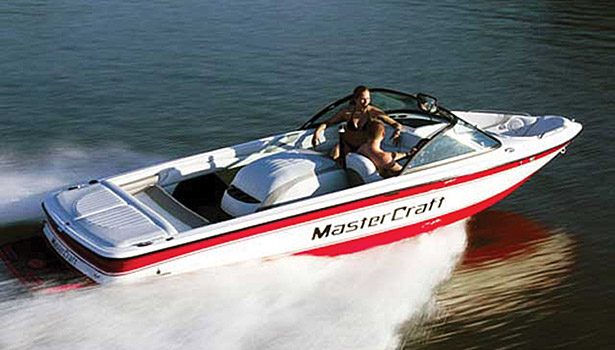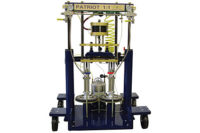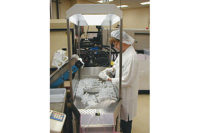Focus On: Pumping and Metering Advancements
Adhesives can provide a better bond than welding or mechanical fasteners in many cases.




The composites industry is full of interesting technologies and products. In the world of composites, diversity can be seen at every turn. It is hard to walk down the street today without bumping into a composite technology or product. You can’t go down a water park slide or take a summer ride in your personal watercraft or boat without feeling the positive impact that composites have on our lives.
In the sky, composites fly through our horizons in the form of airplanes, drones and even spacecraft. On the ground, composites relieve the daily stress of commuting with lightweight, comfortable commuter buses and bicycles. In the water, composites stand out by comprising the bulk of recreational watercraft, as well as many larger vessels for both civilian and military use. Even the Navy SEALs use composites in their armor and watercraft.
Magnum Venus Plastech (MVP) patented fluid impingement technology (FIT) and Patriot metering and pumping technology for use in composites manufacture. In the 1990s, before global climate change and emissions were a hot topic, MVP was striving to lower emissions. FIT technology, which involves the introduction of two streams of fluid into each other to create a low-emission fan pattern, helped reduce environmental impact. In addition, Patriot pumping technology was developed from a new pumping design that improved the accuracy in metering and activating material.
Adhesives are an integral part of composites manufacturing. MVP found that it was a simple process to convert its current pumps and application equipment into adhesive dispensing equipment. Materials such as polyurethanes, epoxies, acrylics, and all types of putties can be efficiently mixed and metered in many ratios. In addition, new products can enable manufacturers to affordably upgrade their process from cartridge to equipment application. As a result, companies are able to reduce material costs and do not have to worry about mix or metered ratios.
“I have been working with MVP now for about eight years and have found their Ultrabond meter mix adhesive dispensers to be very reliable, their engineering to be very inventive, and their customer service unmatched,” said Mike Stewart of Watkins and Associates. “The Ultrabond adhesive dispensers accurately and, more importantly, consistently meter/mix structural adhesives, providing a constant flow delivery system.”
Equipment Considerations
Adhesives can provide a better bond than welding or mechanical fasteners in many cases, but moving large amounts of material takes time and effort. When choosing an adhesive, it is crucial to consider the necessary equipment. Equipment is sometimes considered a peripheral item, but it can actually play a huge factor in adhesive selection. Following are a few factors to keep in mind.
Purpose
Is the adhesive going to work for its intended purpose? In other words, is this wood glue going to work with this particular type of wood? Or will this adhesive work with the special coating on those metals? Once you have narrowed down the field to a couple of specific adhesives, you can begin to look at other considerations.
Material Thickness
Material thickness factors into the adhesive application. Many pieces of equipment will not pump viscosities of 1 million cP. Keep in mind that viscosities can be deceiving, however, and it is helpful to have conversations with your supplier. Some thicker materials are chemically designed to flow better than their thinner counterparts. Thinner materials can also be a challenge because they can easily seep through cracks and cause messes. They may also run off of the part before the bond has had time to perform its function.
On the other hand, using thinner materials sometimes means that you can invest in less expensive equipment to mix and meter. Thinner material is easier to move at faster speeds, while it often requires a great deal of money to move a thicker material. In order to move a material of about 1 million cP at about 5 lbs/min, a very large set of hoses would be needed. It would be necessary to check all of the connections and streamline as many elbow joints as possible. In addition, the dispensing head or gun would need to be moved up a size in order to handle the output. These thicker hoses and larger guns can weigh quite a bit and may cause the operator unneeded strain. Overall, a thicker material requires a more substantial investment, while a thinner material with a similar function could make applications simpler, easier and cheaper.
Fillers
A gap is sometimes needed when bonding two items together, and specific fillers in a material can help create that gap. However, some fillers (e.g., glass beads) can wreak havoc on pumps. To alleviate this problem, certain pumps have been designed specifically to pump adhesives that include glass bead fillers. It may be necessary to augment the type of fillers used with the material itself. Keep in mind that it is not always necessary to have a gap when bonding, and materials companies sometimes use the beads to displace material and make it less expensive to produce.
Ratios
Ratios are important when it comes to choosing both the adhesive and equipment. Different chemicals can react with different ratios, which may play a factor in production. For example, how long will the part need to sit until it has cured and is ready to move to the next stage? How accurate does the metering have to be? Some 1:1 materials are forgiving in terms of accuracy and still provide excellent bonding, while some 10:1 materials need to be very accurate or they will result in a poor bond. Be sure that the ratio of the materials is tailored not just to the bond itself, but to specific production needs.
Quantity
Most of the time, it will be cheaper to buy material in higher quantities; 55-gal drums are usually more cost effective than 5-gal barrels, and 5-gal barrels are more cost effective than individual cartridges. When selecting equipment, however, having a smaller, more mobile system might provide an advantage.
Pails are easier to move around than drums, and they can readily fit into a lean management or just-in-time production system. Larger volumes typically require more square footage of floor space in order to operate the machines. In addition, shelf life can play a factor in choosing purchase quantity. Will you be able to use 55 gal of material before the shelf life is up?
For more information, contact the author at phedgerjr@mvpind.com or visit www.mvpind.com.
Looking for a reprint of this article?
From high-res PDFs to custom plaques, order your copy today!







